Kajima Bundle
How did a carpentry shop in Edo become a global construction giant?
Journey back in time to explore the remarkable Kajima SWOT Analysis and the captivating Kajima history. From its humble beginnings in 1840 as a carpentry business, the Kajima Company has evolved into a multinational powerhouse, shaping skylines and infrastructure worldwide. Discover the pivotal moments and strategic decisions that propelled Kajima Corporation to the forefront of the Japanese construction industry and beyond.
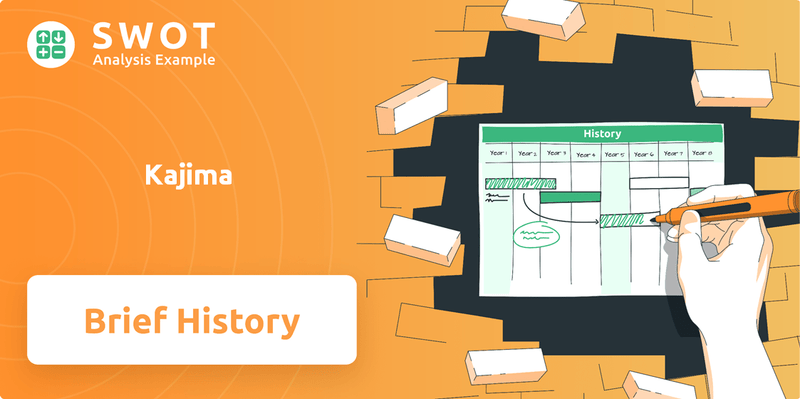
Understanding the Kajima Company's brief history provides invaluable insights into its enduring success and adaptability. This exploration will uncover the key milestones, from its early projects to its global expansion, and its role in shaping modern infrastructure. By examining Kajima's construction techniques and financial performance, we gain a comprehensive understanding of its impact on Japan's economy and its continued relevance in the global construction landscape.
What is the Kajima Founding Story?
The story of the Kajima Company, a prominent player in the global construction industry, begins in 1840. Iwakichi Kajima, a talented carpenter and designer, laid the foundation for what would become a construction giant. His vision and skills set the stage for the company's evolution and its significant contributions to Japan's modernization.
Iwakichi Kajima, born in 1816 in present-day Tokorozawa city, Saitama prefecture, started his journey with training in carpentry in Edo's Yotsuya district. He earned his master's carpentry certificate, which equipped him with the expertise needed to establish his own business. This carpentry shop marked the beginning of the Kajima Company's long and impactful history.
The early years of the Kajima Company were marked by significant milestones that shaped its future. One of the earliest and most impactful projects was the construction of Japan's first Western-style buildings in Yokohama in 1860. This pioneering work, which included Ei-Ichiban Kan (English House No. 1) and America-Ichiban Kan (American House No. 1), demonstrated the company's adaptability and foresight. This shift was crucial as Japan began its transformation into a regional power after the Meiji Restoration in 1868.
In 1880, the company was formally established as 'Kajima Gumi', under the leadership of Iwazo Kajima, Iwakichi's successor. This marked a significant step in the company's growth. The company's entry into the railway construction business, starting with the Tsuruga Railway Line, addressed the growing need for transportation infrastructure.
- The initial funding for the company likely came from its carpentry business.
- The company's growth was fueled by its expanding project portfolio.
- Kajima's early projects were pivotal in shaping Japan's infrastructure.
- The company's ability to adapt to changing needs was key to its success.
Kajima SWOT Analysis
- Complete SWOT Breakdown
- Fully Customizable
- Editable in Excel & Word
- Professional Formatting
- Investor-Ready Format
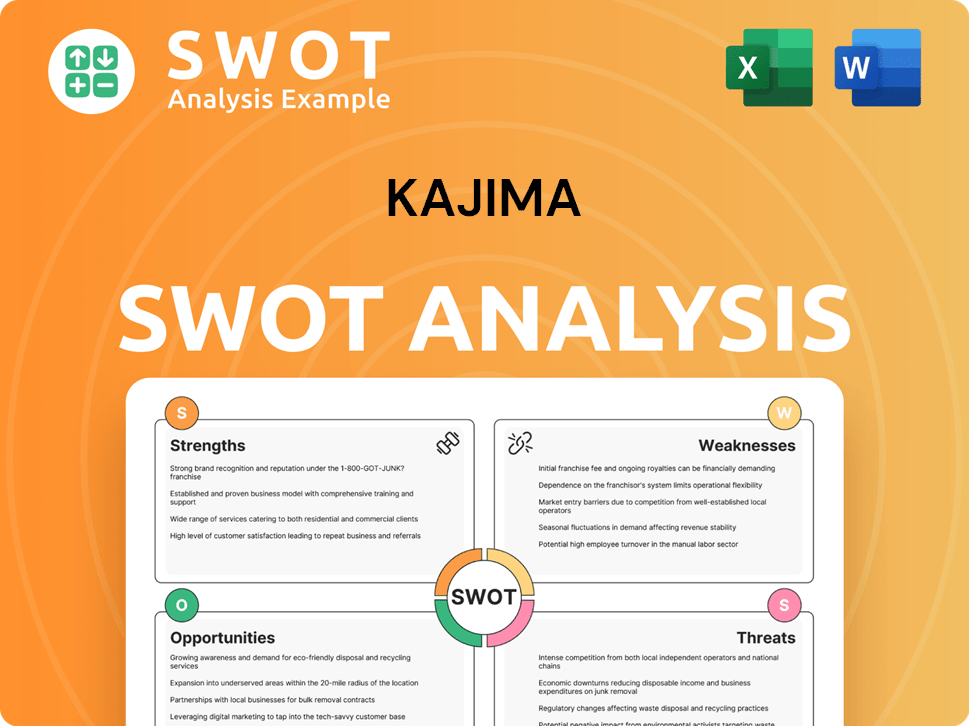
What Drove the Early Growth of Kajima?
The early growth of the Kajima Company, now known as Kajima Corporation, was significantly shaped by Japan's industrial modernization. From its inception as Kajima Gumi in 1880, the company quickly became a key player in the burgeoning railway construction sector. This period marked the beginning of Kajima's journey, setting the stage for its future expansion and impact on the Japanese construction industry. This is just a brief overview of the Growth Strategy of Kajima.
Kajima's initial focus was on railway construction, with projects like the Tsuruga Railway Line, showcasing its expertise in railway bed construction and tunneling. By 1899, Kajima had expanded its railway construction projects internationally, including work in Korea and Taiwan, such as the Gyeongin Line in Korea. These early projects were crucial in establishing Kajima's reputation as a reliable and skilled construction company.
In 1909, Kajima diversified into dam and power plant construction, starting with the Uji River hydroelectric power station. The company was incorporated as a public company on February 22, 1930, with a capitalization of three million yen. This transition allowed Kajima to undertake larger projects, including the main structure of Ueno Station, completed in 1932.
Following World War II, Kajima Gumi was reestablished as the Kajima Construction Company in 1947, playing a vital role in Japan's reconstruction efforts. A significant strategic move in 1949 was the establishment of the Kajima Institute of Construction Technology (KICT), Japan's first research facility of its kind in the construction industry. This institute focused on developing new materials and engineering technologies.
Kajima expanded internationally with a joint venture with Morrison-Knudsen in 1950 for construction works in Okinawa, followed by the Baluchaung hydroelectric power plant in Burma in 1954. The company was listed on the Tokyo and Osaka Stock Exchanges in 1961, which further solidified its financial foundation. By 1964, Kajima International Inc. (KII) was established in Los Angeles, CA, expanding its presence in North America.
Kajima PESTLE Analysis
- Covers All 6 PESTLE Categories
- No Research Needed – Save Hours of Work
- Built by Experts, Trusted by Consultants
- Instant Download, Ready to Use
- 100% Editable, Fully Customizable
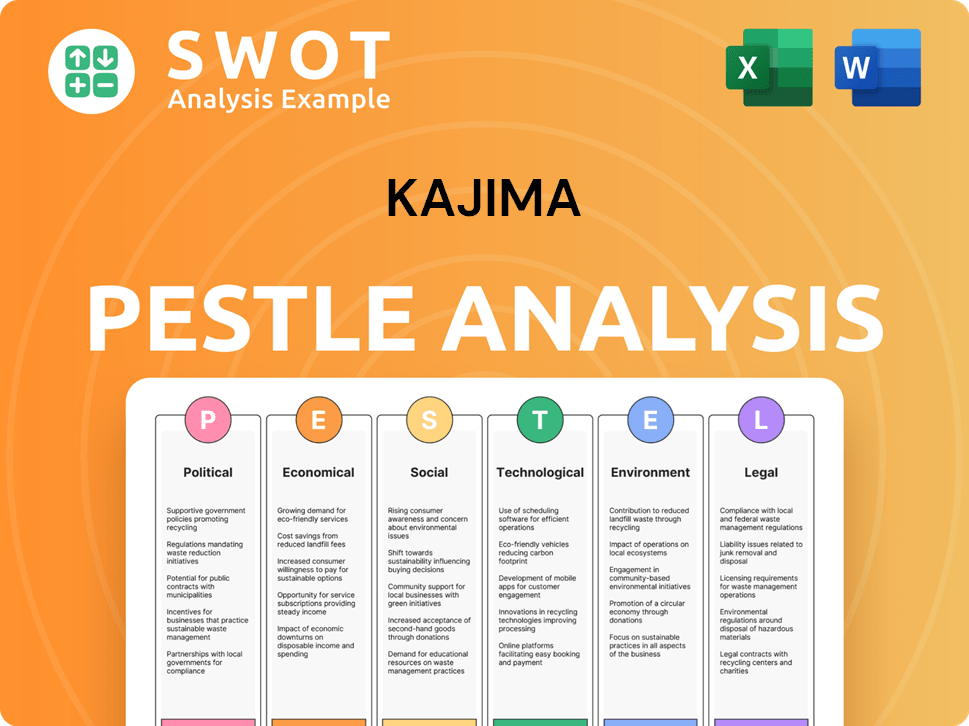
What are the key Milestones in Kajima history?
The Kajima Company has a rich and impactful history, marked by significant milestones in Japanese construction and beyond. These achievements showcase the evolution of the Kajima Group, from its early projects to its current standing as a global player.
| Year | Milestone |
|---|---|
| 1957 | Completed Japan's first nuclear reactor, JRR-1, for the Japan Atomic Energy Research Institute. |
| 1968 | Completed the Kasumigaseki Building, Japan's first high-rise building, demonstrating pioneering urban development. |
| 1985 | Played a crucial role in the Seikan Tunnel's tunneling work, a remarkable feat of civil engineering. |
Innovation has been a core element of Kajima Corporation's strategy, particularly in construction techniques. The establishment of the Kajima Institute of Construction Technology (KICT) in 1949, the first research facility of its kind in Japan's construction industry, underscores this commitment.
Founded in 1949, the Kajima Institute of Construction Technology (KICT) was the first research facility in Japan's construction industry, fostering innovation.
Kajima received the Deming Prize in 1982, a testament to its commitment to quality improvement within the company.
KICT has been instrumental in developing advanced construction materials and engineering technologies, contributing to Kajima's technological prowess.
The company has consistently invested in research and development to enhance its construction techniques and overall efficiency.
Kajima is actively pursuing sustainability initiatives, including the reduction of carbon emissions and the development of eco-friendly construction practices.
Kajima is embracing digital transformation, utilizing technologies such as BIM (Building Information Modeling) and AI to improve project management and construction processes.
Despite its achievements, Kajima Company has faced various challenges throughout its history. The company's financial performance has fluctuated, and it has had to adapt to changing market conditions.
The construction industry downturn in the late 1990s led to a substantial loss of approximately $2.6 billion in 1999 due to debt disposal, impacting Kajima's financial stability.
In response, Kajima expanded operations into the environmental sector, focusing on waste and water treatment, soil rehabilitation, and environmental consulting to diversify its business portfolio.
Kajima aims to achieve carbon neutrality by 2030, with a target to reduce emissions by 25% by 2025 and 50% by 2030, reflecting its commitment to sustainability.
The company has faced legal challenges, including a case for violation of the Antimonopoly Act, with ongoing appeals as of May 2025, impacting its operations.
Kajima's substantial carbon footprint of 1.5 million tons of CO2 in 2023 underscores the scale of its sustainability challenge and the need for emission reduction strategies.
Kajima continues to navigate market fluctuations and economic uncertainties, requiring strategic adaptation and innovative approaches to maintain its competitive edge.
Kajima Business Model Canvas
- Complete 9-Block Business Model Canvas
- Effortlessly Communicate Your Business Strategy
- Investor-Ready BMC Format
- 100% Editable and Customizable
- Clear and Structured Layout
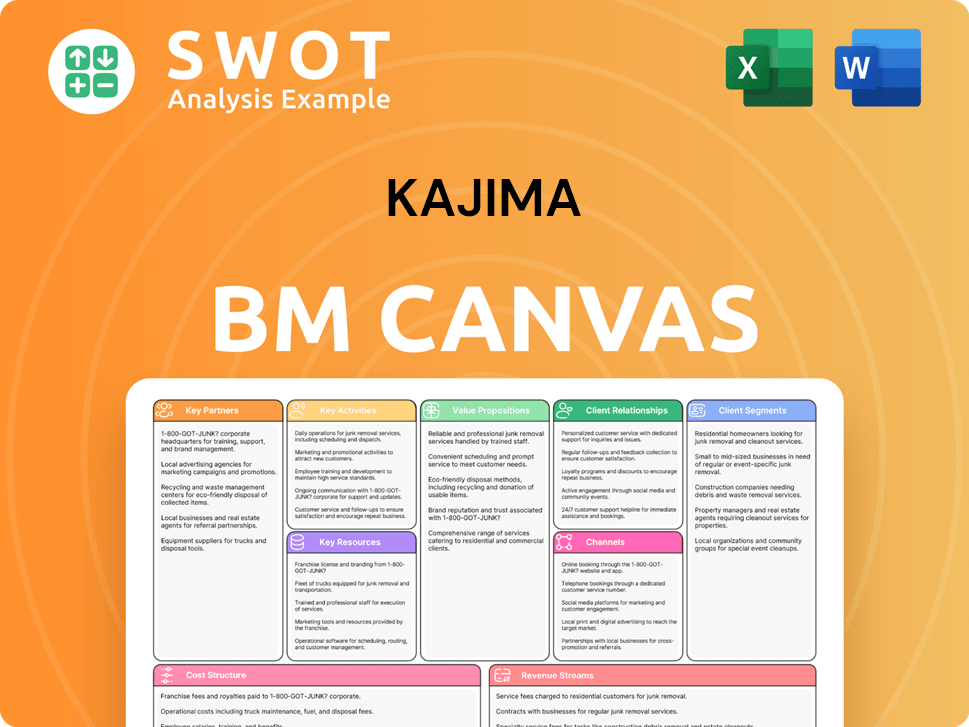
What is the Timeline of Key Events for Kajima?
The Kajima Company, a prominent player in the Japanese construction industry, boasts a rich Kajima history dating back to the 19th century. The journey of Kajima Corporation has been marked by significant milestones, from pioneering Western-style buildings to undertaking massive infrastructure projects and expanding globally. This evolution reflects the company's adaptability and commitment to innovation, solidifying its position as a leader in the construction sector. For more insights, check out the Revenue Streams & Business Model of Kajima.
| Year | Key Event |
|---|---|
| 1840 | Iwakichi Kajima establishes a carpentry business in Edo, setting the foundation for the company. |
| 1860 | The company pioneers Japan's first Western-style buildings in Yokohama, marking an early innovation. |
| 1880 | Kajima Gumi is established and begins railway construction, expanding its infrastructure capabilities. |
| 1930 | Kajima Gumi goes public, signaling a significant step in its corporate development. |
| 1947 | Reestablished as Kajima Construction Company after World War II, rebuilding and modernizing Japan. |
| 1949 | Establishes the Kajima Institute of Construction Technology (KICT), focusing on research and development. |
| 1957 | Completes Japan's first nuclear reactor, JRR-1, showcasing its technological expertise. |
| 1961 | Lists stocks on the Tokyo and Osaka Stock Exchanges, enhancing its market presence. |
| 1968 | Completes Japan's first high-rise building, the Kasumigaseki Building, a landmark achievement. |
| 1970 | Changes name to Kajima Corporation, reflecting its broader scope of operations. |
| 1985 | Completes tunneling work for the Seikan Tunnel, a major feat of engineering. |
| 1999 | Reports a significant loss and launches a 'New Three Year Plan' for recovery and diversification. |
| 2000 | Establishes an environmental division, highlighting its commitment to sustainability. |
| 2017 | Purchases Australian construction company Icon Construction, expanding its global footprint. |
| 2023 | Akita Port & Noshiro Port Offshore Wind Farm starts operations, with Kajima as the general contractor. |
| 2024 | IHG Hotels & Resorts and Kajima Corporation sign an agreement to open ANA Holiday Inn Resort Karuizawa in 2025. |
| 2025 | Financial statements for the fiscal year ended March 31, 2025, are announced, showing a fourth consecutive year of revenue and income growth. |
For the fiscal year ending March 31, 2025 (FY2024), Kajima reported consolidated revenues of 2,911,816 million JPY, a 9.3% year-on-year increase. Consolidated net income attributable to owners of the parent was 125,817 million JPY, up 9.4% year-on-year. The company forecasts a record-high consolidated net income of 130.0 billion yen for FY2025.
Kajima aims to increase its international revenue contribution to 40% of total revenue by 2025, up from approximately 35% in FY2023. The company is focusing on strengthening core businesses, creating new value, and promoting ESG measures for growth. The '& INNOVATION 2030' vision guides its long-term strategic initiatives.
Future growth is expected from domestic civil engineering and building construction, as well as rising profits from domestic and overseas subsidiaries. Well-timed property sales in the U.S. and European real estate development businesses are anticipated. Civil engineering gross profit margins are projected to exceed 17% in fiscal 2025.
The company aims to achieve carbon neutrality by 2050. Kajima's commitment to innovation, sustainability, and global expansion ties back to its founding vision of contributing to society through building and development. The Kajima Group continues to invest in new technologies.
Kajima Porter's Five Forces Analysis
- Covers All 5 Competitive Forces in Detail
- Structured for Consultants, Students, and Founders
- 100% Editable in Microsoft Word & Excel
- Instant Digital Download – Use Immediately
- Compatible with Mac & PC – Fully Unlocked
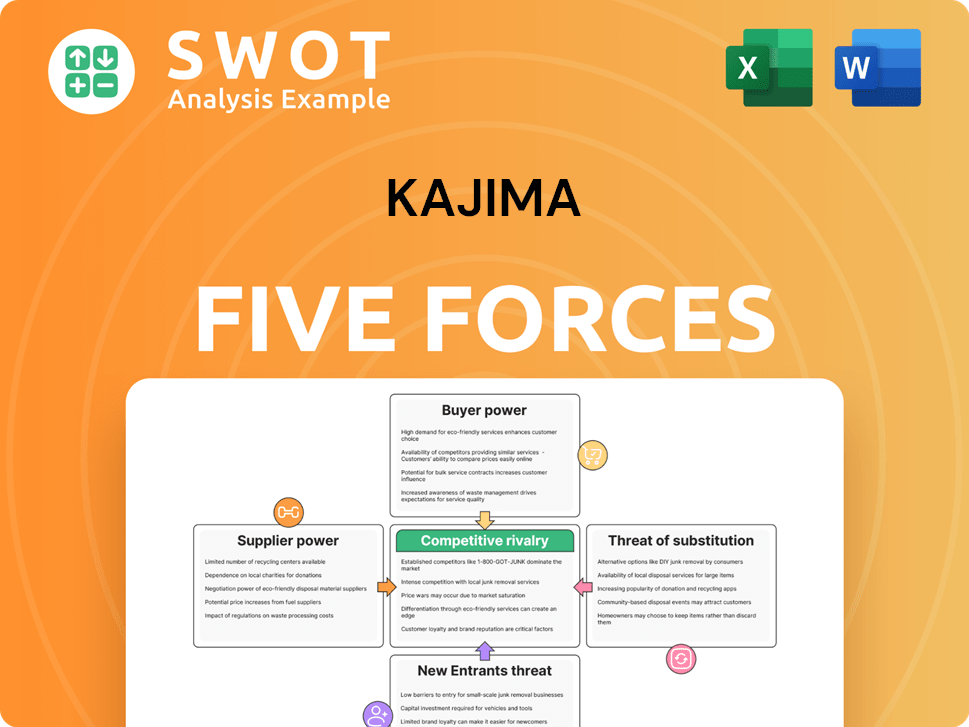
Related Blogs
- What is Competitive Landscape of Kajima Company?
- What is Growth Strategy and Future Prospects of Kajima Company?
- How Does Kajima Company Work?
- What is Sales and Marketing Strategy of Kajima Company?
- What is Brief History of Kajima Company?
- Who Owns Kajima Company?
- What is Customer Demographics and Target Market of Kajima Company?
Disclaimer
All information, articles, and product details provided on this website are for general informational and educational purposes only. We do not claim any ownership over, nor do we intend to infringe upon, any trademarks, copyrights, logos, brand names, or other intellectual property mentioned or depicted on this site. Such intellectual property remains the property of its respective owners, and any references here are made solely for identification or informational purposes, without implying any affiliation, endorsement, or partnership.
We make no representations or warranties, express or implied, regarding the accuracy, completeness, or suitability of any content or products presented. Nothing on this website should be construed as legal, tax, investment, financial, medical, or other professional advice. In addition, no part of this site—including articles or product references—constitutes a solicitation, recommendation, endorsement, advertisement, or offer to buy or sell any securities, franchises, or other financial instruments, particularly in jurisdictions where such activity would be unlawful.
All content is of a general nature and may not address the specific circumstances of any individual or entity. It is not a substitute for professional advice or services. Any actions you take based on the information provided here are strictly at your own risk. You accept full responsibility for any decisions or outcomes arising from your use of this website and agree to release us from any liability in connection with your use of, or reliance upon, the content or products found herein.